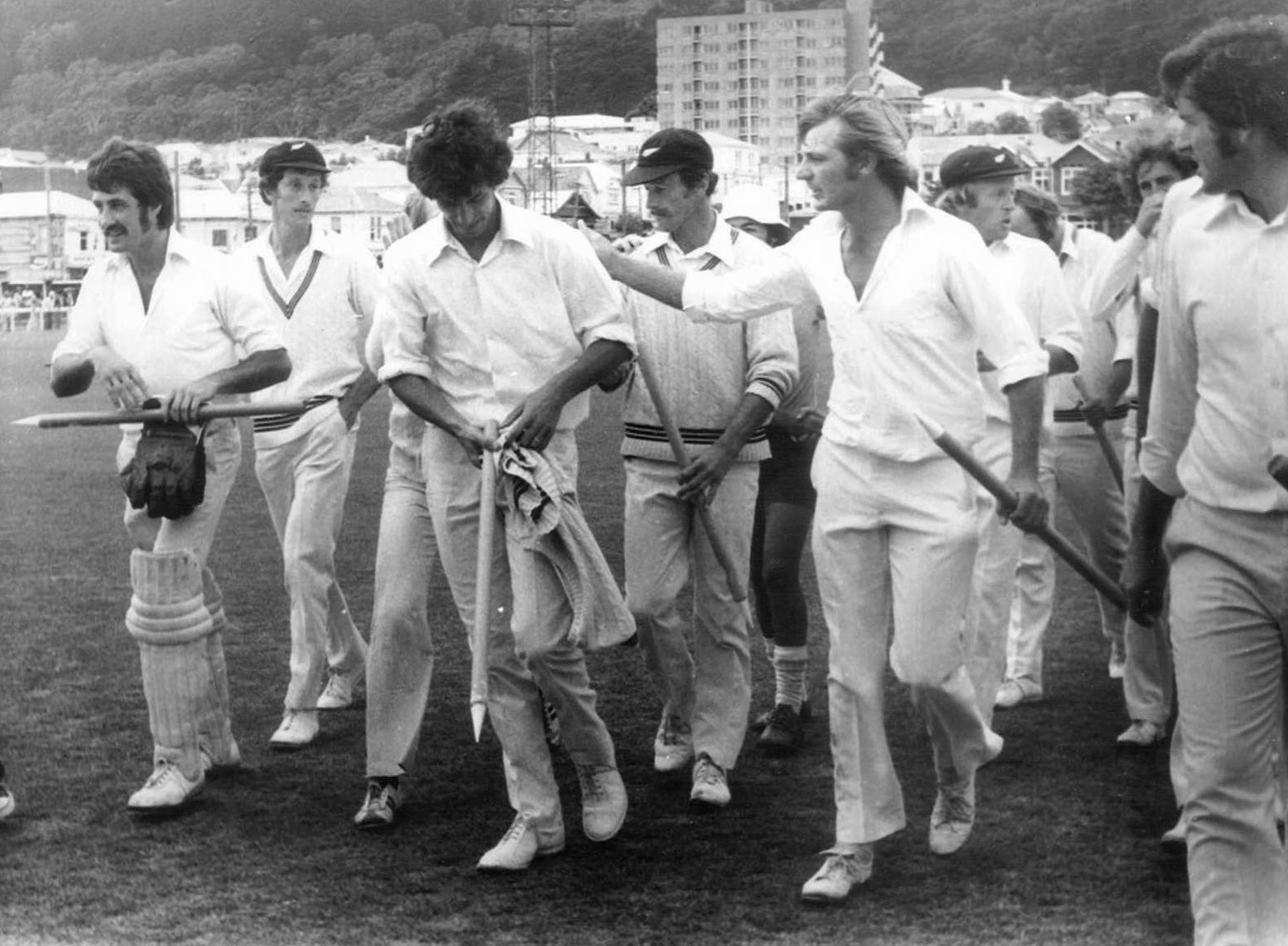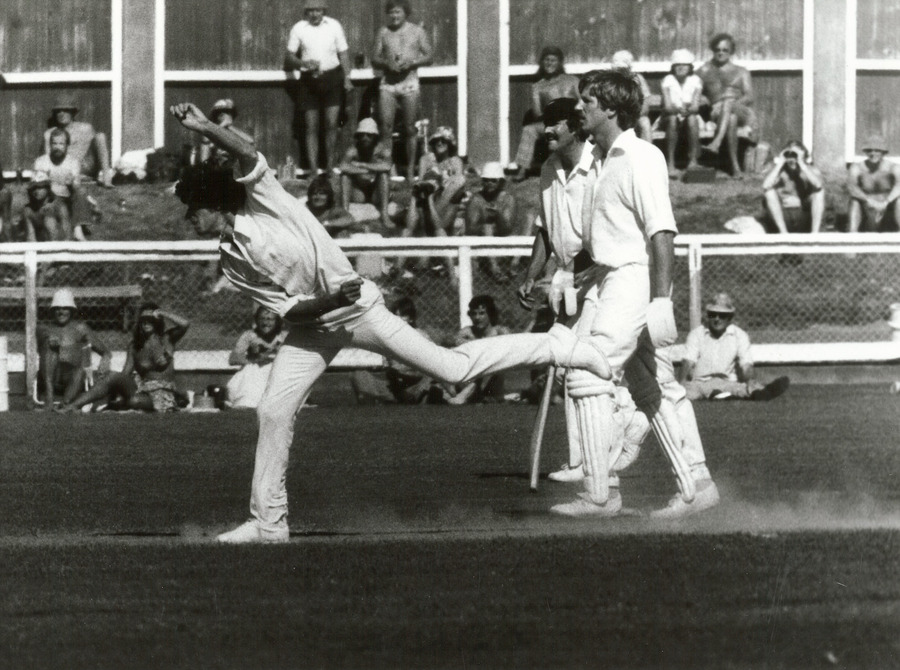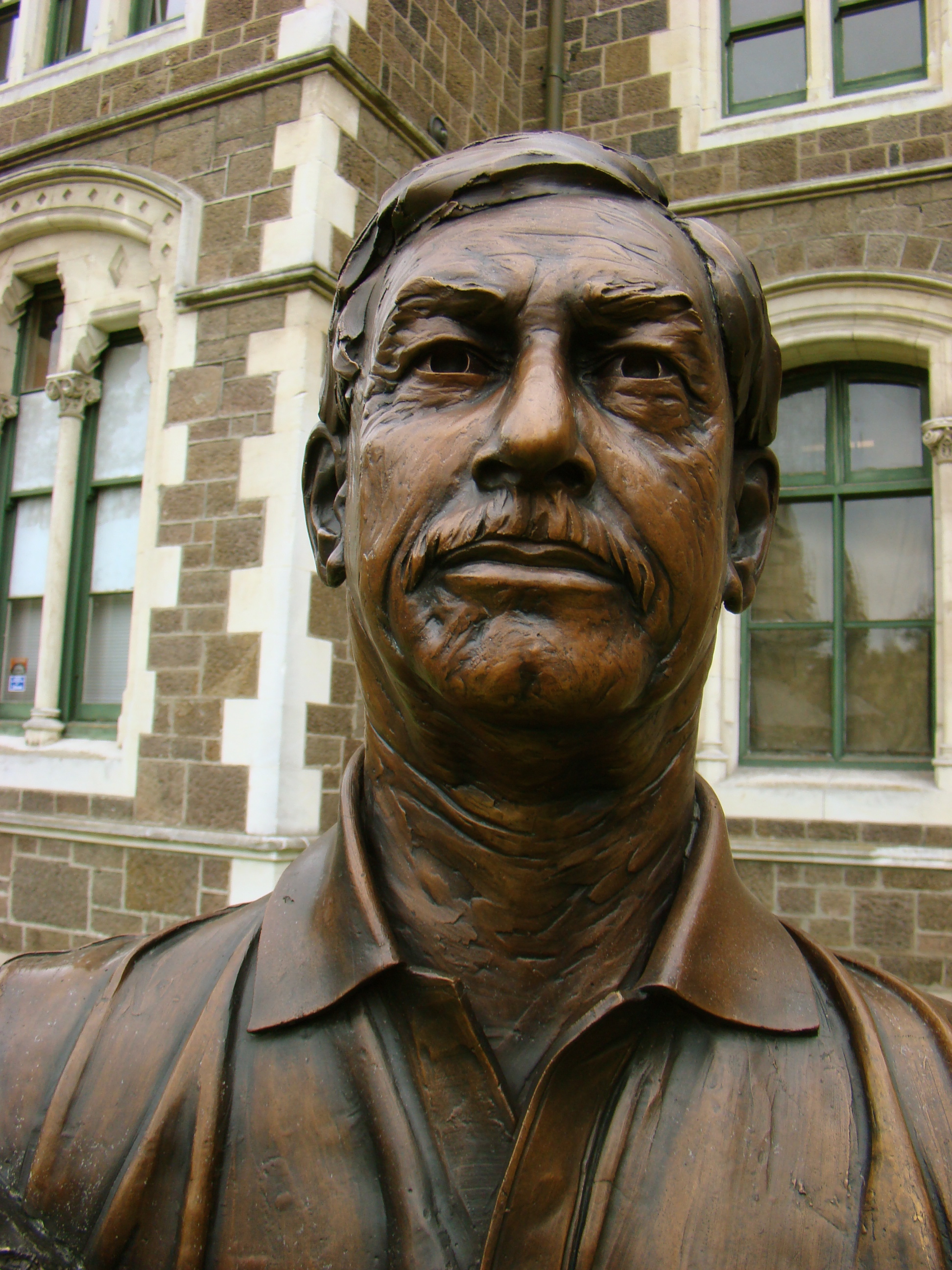1. Early Life and Family Connections
Sir Richard Hadlee's early life was deeply intertwined with cricket, with several family members also achieving international recognition in the sport.
1.1. Birth and Childhood
Richard Hadlee was born on 3 July 1951 in St Albans, Christchurch, New Zealand. His early environment fostered a strong connection to cricket, given his family's significant involvement in the sport.
1.2. Family Members and Cricket Ties
Cricket was a prominent pursuit within the Hadlee family. His father, Walter Hadlee, and two of his four brothers, Dayle and Barry, all played for the New Zealand national cricket team. Furthermore, his former wife, Karen, also represented New Zealand in international cricket. This rich family legacy contributed significantly to Richard's own cricketing journey.
2. Cricket Career
Richard Hadlee's cricket career spanned both the international and domestic stages, where he achieved remarkable success as a bowling all-rounder.
2.1. International Test and ODI Career
Hadlee's international career with the New Zealand national team was distinguished by his record-breaking bowling performances and crucial all-round contributions.
2.1.1. Early Career and Breakthrough
Hadlee made his first-class debut for Canterbury in 1971/72 and his Test match debut in 1973. Despite an inconsistent start at the Test level, he solidified his place in the team with a breakthrough performance against India in 1976, taking 11 wickets in a game that New Zealand won. In 1978, he played a pivotal role in New Zealand's historic first win over England, taking 6 for 26 in England's second innings to dismiss them for 64 while chasing 137.

2.1.2. Peak Performance and World Records
The period from 1979 onwards saw Hadlee reach the pinnacle of his career. In the 1979/80 home Test series against a formidable West Indies side, he secured an 11-wicket haul in the first Test, contributing to a shock one-wicket victory for New Zealand in Dunedin. In the second Test, he scored his maiden Test century, helping New Zealand draw the match and win the series 1-0, initiating a 12-year unbeaten home record for New Zealand in Test match series. For these services to cricket, he was appointed an MBE in the 1980 Queen's Birthday Honours.
A 1983 tour to England marked New Zealand's first Test win on English soil at Headingley. Although Hadlee had an uncharacteristically modest bowling return in that match, he topped both batting and bowling averages for New Zealand in the series and took his 200th Test wicket in the final Test at Nottingham. In the return series in New Zealand in 1984, Hadlee delivered a superb all-round performance in Christchurch, taking 8 wickets and scoring a rapid 99 runs in a three-day innings victory over England, where England were dismissed for less than 100 in both innings. These efforts propelled him to the number one ranking in the ICC Test Bowling Rankings in 1984, a position he held until 1988.
The 1985/86 series in Australia was a defining moment, where Hadlee transformed into a truly great fast bowler. In the first Test at Brisbane, he recorded his personal Test best of 9 for 52 in Australia's first innings. He followed this with a batting contribution of 54 runs and 6 more wickets in Australia's second innings, leading New Zealand to a crushing innings victory. He secured 7 wickets in the second Test loss and 11 wickets in the third Test victory, giving New Zealand their first series win on Australian soil, with Hadlee personally taking 33 wickets across the three Tests. In the first Test of the return series in New Zealand, he took his 300th Test wicket by trapping Australian captain Allan Border leg before wicket.
In 1986, Hadlee helped New Zealand achieve their first series win over England in England. His outstanding performance in the second Test at Nottingham, his county 'home', saw him take 10 wickets and score 68 runs, powering New Zealand to victory. During this match, Hadlee caused controversy by felling England wicketkeeper and Nottinghamshire teammate Bruce French with a bouncer, hospitalizing him. In March 1987, a disagreement with captain Jeremy Coney during a Test against West Indies in Christchurch led to the pair communicating through John Wright on the field.
In April 1987, New Zealand toured Sri Lanka, where Hadlee scored his second Test century, an unbeaten 151 in the first Test, helping New Zealand save the game. The tour was cut short after a terrorist bomb, planted by the Tamil Tigers separatist movement, exploded near the New Zealand team's hotel in Colombo, killing 113 civilians. Although not believed to be directed at the team, they voted to return home after only one of the scheduled three Tests.
Hadlee's competitive spirit against Australia resurfaced in 1987/88 when he captured 10 wickets in the third Test of a three-match series in Australia, almost leading New Zealand to an improbable series-equalling victory. The match concluded with Australia's number eleven batsman Michael Whitney barely surviving a grueling final over from an exhausted Hadlee. A wicket in that over would have given New Zealand victory and Hadlee his 374th Test wicket, breaking Ian Botham's world record. In the subsequent home series against England, Hadlee broke down injured on the first day of the first Test, forcing him to miss the remainder of the series. Australian commentator Richie Benaud later expressed doubt that Hadlee would play again after seeing him hobble on crutches at an awards dinner.
Following a successful rehabilitation, Hadlee returned to claim the world record for Test wickets against India in 1988. Despite a previous decision not to play in India due to stomach troubles, the opportunity to make history was too compelling. He secured his 374th Test wicket in the first Test of the series. In the second Test, a 10 wicket haul helped New Zealand achieve a rare Test win in India, though they ultimately lost the series 2-1.
In a home series against India in 1989/90, Hadlee became the first bowler in history to take 400 Test wickets when he dismissed Sanjay Manjrekar in the second innings of the first Test on his home ground in Christchurch, as former schoolmates sang their school song. After helping New Zealand to another Test victory over Australia in Wellington by taking his 100th first-class 5 wicket haul in an innings, Hadlee announced his retirement following the upcoming tour to England.
In ODI history, Hadlee became the first player to achieve the double of scoring 1,000 runs and taking 100 wickets. At the time of his retirement, he held the record for the most five-wicket hauls in Test cricket, with 36, in addition to five in ODIs. He was also the second fastest bowler, and the fastest seamer, to achieve 25 five-wicket hauls in Test matches, doing so in 62 matches. His figures of 9/52 in the first innings of the first Test against Australia at The Gabba in 1985 represent the best single-innings bowling performance by any fast bowler in the 20th century.
2.1.3. Retirement and Knighthood
Just before the second Test of the 1990 England series at Lord's, the 1990 Queen's Birthday Honours were announced, which included Hadlee's appointment as a Knight Bachelor for his services to cricket. He was formally invested with his knighthood on 4 October 1990, after his final Test match on 10 July 1990, although he became "Sir Richard" upon the publication of the Honours List. Only one other person, Lt.-Col. Sir Vizzy, had been knighted for services to cricket while an active Test cricketer (in 1936), though Vizzy's knighthood recognized administrative rather than playing contributions. Hadlee often noted that he was the first bowler to receive a knighthood since Sir Francis Drake. He celebrated his knighthood by scoring 86 runs in New Zealand's first innings and earning the man of the match award. In the final Test of the series, Hadlee concluded his Test career by taking 5 wickets in his final bowling performance, and remarkably, he took a wicket with the final ball of his Test career.
When his father, Walter Hadlee, was asked to vote for the 2000 edition of Wisden for his choice of the five cricketers of the 20th century, he included Richard, stating it was "embarrassing ... But there's a job to be done. I will cite the bare facts." He considered Dennis Lillee but found Richard's Test match performance marginally superior. Richard Hadlee ultimately received thirteen votes from the 100 electors, placing him equal tenth as a player of the century.
2.2. Domestic League Career
Beyond international cricket, Hadlee also had a significant impact in English county and New Zealand provincial cricket.
2.2.1. Nottinghamshire Career
Richard Hadlee represented Nottinghamshire between 1978 and 1987. During this time, he played only three full seasons due to injuries and international commitments, yet his bowling figures were remarkable, especially on the often overgrassed Trent Bridge pitches. Notable performances include his 8 for 22 against Surrey in 1984. His bowling statistics for his three full seasons were:
- 1981: 4252 balls, 231 maidens, 1564 runs, 105 wickets for 14.89 each.
- 1984: 4634 balls, 248 maidens, 1645 runs, 117 wickets for 14.05 each.
- 1987: 3408 balls, 186 maidens, 1154 runs, 97 wickets for 11.89 each, which was the lowest average since 1969.
In each of these three seasons, his peers of the Professional Cricketers' Association (PCA) voted him the PCA Player of the Year. He also received The Cricket Society Wetherall Award for the Leading All-Rounder in English First-Class Cricket in 1982, 1984, 1986, and 1987. In the 1984 county season, Hadlee achieved the rare feat of completing the county 'double', scoring 1,000 runs and taking 100 wickets in the same season. He and his successor at Nottinghamshire, Franklyn Stephenson, are the only two players to achieve this in English county cricket since the reduction in county games per season in 1969. The runs component of his double included his highest first-class score, 210 not out in a victory over Middlesex at Lord's. In 1987, his final season, he narrowly missed the double as Nottinghamshire won the County Championship, mirroring their success in 1981. Hadlee's contribution with both bat and ball was immense in these triumphs.
2.2.2. Canterbury and Other Sporting Activities
Due to seasonal differences, Hadlee also played provincial cricket for his home team, Canterbury. In recognition of his and his family's contributions to Canterbury and New Zealand cricket, the now-demolished north stand of the earthquake-damaged AMI Stadium in Christchurch was named the Hadlee stand. The Chappell-Hadlee Trophy, regularly contested between New Zealand and Australia in one-day matches, is named after the Hadlee family of New Zealand and the Chappell family of Australia.
Beyond cricket, Hadlee was also a competent association football player, playing for the Southern League team Rangers A.F.C. in Christchurch.
2.3. Playing Style
Richard Hadlee's playing style was characterized by his formidable pace bowling and aggressive left-handed batting.
2.3.1. Bowling Style

Hadlee was a right-arm pace bowler. While initially extremely fast in his youth, he later shortened his run-up, which enhanced his accuracy and ability to generate significant movement off the wicket and in the air. His most dangerous delivery became the outswinger, a key weapon in the latter part of his career.
A major influence on Hadlee's development and career was Dennis Lillee, whom he regarded as the epitome of a fast bowler. Hadlee admired Lillee's strength, fitness, confidence, aggression, skill, technique, and ability to intimidate batsmen. In challenging game situations, Hadlee would often reflect on "what would Lillee do" and strive to emulate his determination. Lillee himself, in his autobiography Menace, described Hadlee as "super skillful," noting him as the first true professional he observed in Test matches, delivering serial outswingers on the off stump, occasionally mixing in an inswinger or cutter, an odd bouncer, and rarely a yorker.
Hadlee's economical bowling action was distinctive for his close approach to the wicket at the bowler's end, sometimes even dislodging the bails. This line enabled him to trap many batsmen leg before wicket. He broke the Test-wicket taking record by claiming his 374th wicket on 12 November 1988 in Bangalore, India. His 400th Test wicket was achieved on 4 February 1990, and remarkably, he took a wicket with the final ball of his Test career on 9 July 1990, dismissing Devon Malcolm for a duck.
2.3.2. Batting Style
Hadlee was an aggressive left-handed middle-order batsman. While his batting record was less dominant against top international bowlers, he was highly effective at punishing less formidable attacks. He concluded his career with 15 Test fifties and two Test centuries. For Nottinghamshire, in the 1984, 1986, and 1987 seasons, he maintained a batting average of over 50. This is a rare feat in cricket, with only W.G. Grace and George Herbert Hirst having achieved comparable success in heading both batting and bowling averages in a season.
3. Personal Life and Health
Sir Richard Hadlee has faced significant health challenges that have impacted his personal life, but he has maintained an active lifestyle.
3.1. Health Issues and Recovery
Six months after his retirement, in July 1991, Hadlee underwent heart surgery upon discovering he had Wolff-Parkinson-White syndrome. He had lived with the syndrome since birth, experiencing symptoms such as an irregular heartbeat throughout his playing career. Despite this, he continues to lead an active life and collaborates with the Heart Foundation. In June 2018, Hadlee was diagnosed with bowel cancer and subsequently underwent surgery for tumor removal.
4. Post-Retirement Activities
After retiring from playing, Richard Hadlee has remained actively involved in cricket and has dedicated efforts to social causes.
4.1. Cricket-Related Roles
In his post-playing career, Richard Hadlee has taken on administrative and advisory roles within cricket. He served as a former chairman of the New Zealand board of selectors, contributing to the strategic direction of New Zealand cricket.
4.2. Social Contributions
In August 1990, Hadlee established 'The Sir Richard Hadlee Sports Trust'. The trust's mission is to provide support to aspiring sportsmen and women who face hardship, enabling them to pursue success in their chosen sporting or cultural disciplines. The criteria for assistance from the trust stipulate that applicants must be under 25 years old, hail from the Canterbury region of New Zealand, and require assistance specifically for sporting or cultural purposes due to disadvantage, hardship, or special circumstances preventing them from achieving their goals. The trust operates through the generosity of the community and corporate sponsors such as CTV, Lion Nathan, Newstalk ZB, Pernod Ricard, Pope Print, PR South, and Vbase.

5. Awards and Honours
Richard Hadlee has received numerous individual awards and accolades throughout his distinguished career, recognizing his immense contributions to cricket.
5.1. Major Sporting Awards and National Honours
Hadlee's extensive list of honors includes national appointments and prestigious sporting awards. He was appointed an MBE for services to New Zealand sport in 1980 and subsequently awarded a Knighthood for services to cricket in 1990.
His individual sporting achievements include winning the Windsor Cup on 13 occasions, including 12 consecutive years, for the most meritorious bowling performance of the season. He was named New Zealand Sportsman of the Year in both 1980 and 1986. In 1987, he was recognized as the New Zealand Sportsperson of the last 25 years, an honor he shared with runner John Walker, and also as the New Zealand Sportsperson of the Decade.
Internationally, Hadlee was named Wisden Cricketer of the Year in 1982. In 2008, he received the Bert Sutcliffe Medal, and in 2009, he was inducted into the ICC Cricket Hall of Fame. Most recently, in 2024, he was inducted into the NZC Hall of Fame as one of the inaugural First XI.
6. Legacy and Impact
Richard Hadlee's legacy extends far beyond his statistics, profoundly influencing cricket history and shaping public recognition of the sport in New Zealand and globally.
6.1. Influence on Cricket
Hadlee's playing style, particularly his mastery of bowling with the new ball and his formidable outswinger, significantly influenced fast bowling. He set new standards for consistency and impact, inspiring a generation of bowlers. His approach, including his economical action and ability to trap batsmen leg before wicket, became a reference point for analysis and emulation. He was considered one of the greatest fast bowlers of his era, despite competing alongside contemporaries such as Dennis Lillee, Imran Khan, Andy Roberts, Michael Holding, Joel Garner, Kapil Dev, Ian Botham, Wasim Akram, and Malcolm Marshall. As one of the four top all-rounders of his time, alongside Imran Khan, Kapil Dev, and Ian Botham, Hadlee possessed the best bowling average among them.
His standing in cricket history is consistently high. In December 2002, Wisden selected him as the second greatest Test bowler of all time. His father, Walter Hadlee, even included Richard in his selection for the five cricketers of the 20th century for Wisden's 2000 edition, a testament to his undeniable impact. Richard Hadlee garnered thirteen votes from the 100 electors for the Player of the Century, placing him equal tenth.
6.2. Public Recognition and Commemoration
Richard Hadlee's contributions to cricket are widely recognized and commemorated in New Zealand and internationally. In March 2009, he was honored as one of the Twelve Local Heroes in Christchurch, and a bronze bust depicting him was unveiled outside the Christchurch Arts Centre. The now-demolished north stand of the AMI Stadium was named the Hadlee stand, acknowledging the entire Hadlee family's contributions to Canterbury and New Zealand cricket. The Chappell-Hadlee Trophy, a one-day international cricket series contested between New Zealand and Australia, further immortalizes his family name alongside the prominent Australian Chappell family.